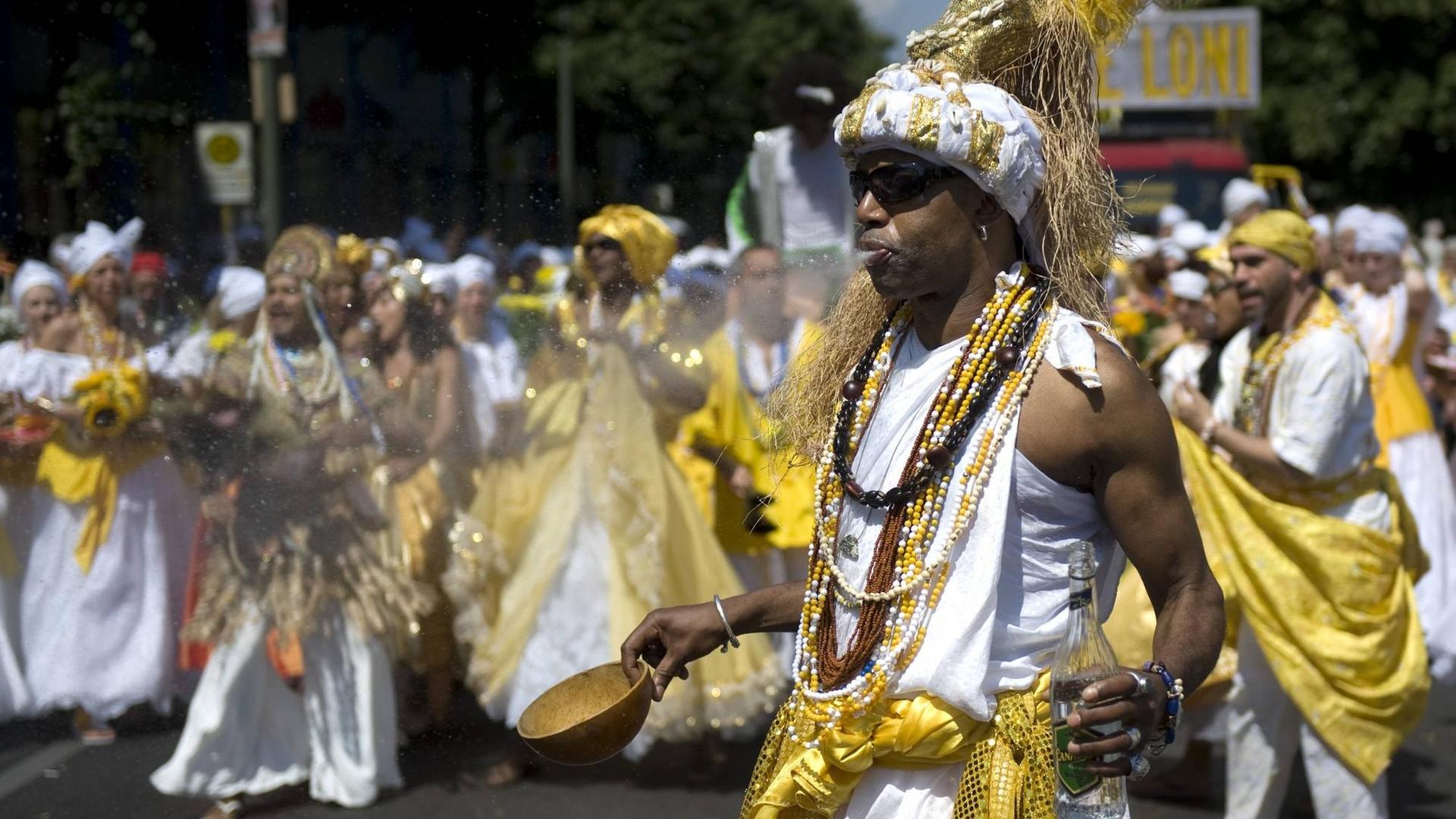
Candomble is an Afro-Brazilian religion that traces its roots back to the enslaved African people who were brought to Brazil during the colonial era. It is a captivating and vibrant religious practice that combines elements of African animism with Catholicism. Candomble is rich in tradition, rituals, and beliefs that are deeply intertwined with nature, spirits, and ancestors.
In this article, we will explore 18 fascinating facts about Candomble that will provide you with a deeper understanding of this unique religion. From its origins to its rituals and beliefs, Candomble offers a fascinating glimpse into the spiritual practices of the Afro-Brazilian community. So, let’s delve into the world of Candomble and uncover the mysteries and beauty it holds.
Key Takeaways:
- Candomble is an Afro-Brazilian religion that combines African traditions with Catholicism, promoting inclusivity and facing discrimination throughout its history.
- Candomble ceremonies involve drumming, singing, and dancing, making it a vibrant and celebratory religion that promotes healing and spiritual growth.
Candomble is an Afro-Brazilian religion.
Originating in Brazil, Candomble is a vibrant and syncretic religion that combines elements of African spiritual traditions with Catholicism.
It has roots in West African religions.
Candomble traces its ancestry back to the Yoruba, Fon, and Bantu religious practices brought to Brazil by enslaved Africans during the transatlantic slave trade.
The word “Candomble” means dance in honor of the gods.
The term “Candomble” is derived from the Bantu word “kandombele,” which signifies a gathering for religious ceremonies accompanied by music and dance.
There are various Candomble deities.
Candomble worship centers around orixas, gods and goddesses representing natural forces and human qualities, such as Oxum (goddess of love and fertility) and Xango (god of thunder and justice).
Initiates are called “filhos de santo.”
In Candomble, individuals who undergo initiation and become members of the religion are known as “filhos de santo” or “children of the saint.
Candomble ceremonies involve drumming, singing, and dancing.
Music plays a vital role in Candomble rituals, with rhythmic drumming, chanting, and dancing creating a powerful and energetic atmosphere.
Offerings are made to the orixas.
Devotees of Candomble make offerings of food, drinks, and other items to the orixas as a form of reverence and to forge a spiritual connection.
There are Candomble houses of worship called terreiros.
Terreiros serve as sacred spaces where Candomble rituals, ceremonies, and initiations take place, fostering a sense of community and spiritual growth.
Candomble is practiced in Brazil and beyond.
Although its origins are rooted in Brazil, Candomble has gained followers and recognition in other parts of the world, including the United States, Europe, and Africa.
It is a religion of inclusivity and tolerance.
Candomble embraces diversity and promotes acceptance, welcoming individuals from various backgrounds and walks of life into its community.
Candomble has faced persecution and discrimination.
Throughout its history, Candomble has encountered resistance and oppression, with its practitioners facing discrimination due to their religious beliefs.
The religion incorporates elements of Catholicism.
As a result of historical blending, Candomble incorporates certain Catholic symbols and practices, allowing it to coexist alongside mainstream society.
Divination is an integral part of Candomble.
Candomble practitioners seek guidance and insight through divination methods such as the throwing of shells or the interpretation of cowrie shells.
Candomble ceremonies often involve trance possession.
During rituals, initiated members may become possessed by orixas, allowing the deities to manifest and communicate through them.
Each orixa has specific attributes and characteristics.
Individual orixas possess distinct qualities and traits, and their worshippers seek their blessings and guidance in various aspects of life.
Candomble promotes healing and spiritual growth.
Through its rituals and practices, Candomble aims to bring about spiritual healing, personal transformation, and a deeper connection with the divine.
Music and dance are central to Candomble worship.
The rhythmic drumming, vibrant singing, and energetic dancing in Candomble ceremonies create a lively and celebratory atmosphere.
Candomble preserves and celebrates African culture.
As a dynamic and living spiritual tradition, Candomble serves as a vessel for the preservation and celebration of African cultural heritage in Brazil and beyond.
Conclusion
In conclusion, Candomble is a rich and fascinating religion that originated in Brazil. Its origins can be traced back to the blend of African spiritual beliefs brought by enslaved people and the influence of indigenous and European cultures. Today, Candomble continues to thrive and evolve, offering its practitioners a profound connection to the spiritual world and a sense of community.Through its vibrant rituals, intricate cosmology, and the worship of deities known as Orixas, Candomble provides a space for healing, empowerment, and spiritual growth. It celebrates the diversity of human experiences and acknowledges the interconnectedness of all beings.As we have explored in this article, Candomble is rooted in a deep respect for nature, ancestors, and the divine. Its rituals, music, dance, and oral tradition provide a powerful means of expression and connection to the spiritual realm.Whether you are interested in learning more about different religions or seeking a spiritual path that embraces diversity and inclusivity, Candomble offers a valuable perspective that enriches our understanding of the world and the divine.
FAQs
1. What is the significance of the Orixas in Candomble?
The Orixas are divine entities worshipped in Candomble. They represent different aspects of nature, emotions, and human experiences, providing spiritual guidance and protection to their devotees.
2. Is Candomble practiced outside of Brazil?
Although Candomble originated in Brazil, it has spread to other parts of the world. Today, you can find Candomble communities and practitioners in countries such as Argentina, Uruguay, and the United States.
3. Are there any rituals or ceremonies in Candomble?
Yes, rituals and ceremonies are an integral part of Candomble. They involve music, dance, prayers, and offerings to the Orixas. These rituals aim to establish a connection between the human and divine realms.
4. Can anyone practice Candomble?
Candomble is open to anyone who is genuinely interested and respectful of its practices and beliefs. It embraces diversity and welcomes people from different backgrounds and walks of life.
5. How does Candomble view the concept of divinity?
In Candomble, divinity is seen as a complex and interconnected web of spiritual forces. The Orixas are regarded as manifestations of the divine and are venerated as intermediaries between the human and divine realms.
6. Does Candomble have any ethical guidelines or principles?
Yes, Candomble emphasizes respect, compassion, and harmony with nature and others. It promotes a sense of community, social responsibility, and the recognition of the interdependence of all living beings.
7. How can one learn more about Candomble?
To learn more about Candomble, you can read books, attend workshops or events, or connect with knowledgeable practitioners. Engaging in respectful conversations and immersing yourself in the traditions and rituals can deepen your understanding of this vibrant religion.
Candomble's rich tapestry of spiritual practices and cultural heritage captivates the soul, inviting further exploration into the realm of sacred traditions. For those seeking to delve deeper into the world of divine rituals, the mesmerizing Thaipusam Festival awaits, promising an immersive journey into the heart of spiritual rituals that transcend time and space.
Was this page helpful?
Our commitment to delivering trustworthy and engaging content is at the heart of what we do. Each fact on our site is contributed by real users like you, bringing a wealth of diverse insights and information. To ensure the highest standards of accuracy and reliability, our dedicated editors meticulously review each submission. This process guarantees that the facts we share are not only fascinating but also credible. Trust in our commitment to quality and authenticity as you explore and learn with us.


